Phytomolecules for Obesity and Body Weight Management
Received: 30-Nov-2017 / Accepted Date: 20-Dec-2017 / Published Date: 05-Jan-2018
Abstract
Obesity is one of the most prevailing health issues worldwide. It has been commonly found to be associated with metabolic disorders such as diabetes, hypertension, cardiovascular diseases and some form(s) of cancers. Excessive energy intake, physical inactivity and genetic susceptibility are main causal factors for obesity. In the modern era, various medicines have been developed for overweight and obese people, but nearly all these have serious side effects. Currently, plant-based natural products as anti-obesity therapeutics are largely unexplored. Many plant-derived molecules have been found to possess anti-obesity effects with advantages over chemical treatments. So there is a basic need to develop effective drugs for obesity management/treatment with minimal side effects. Plants may prove promising options for the same. Natural plant products are widely used in healthcare or as dietary supplements. The important phytomolecules include flavonoids, terpenoids, saponin, phenols and alkaloids. The majority of plant extracts are not single compounds but rather a mixture of different molecules, therefore their mechanism of action usually targets several organ and cellular systems. The phytomolecules would act through their inhibitory activities for pancreatic lipases, adipocyte differentiation or by increasing thermogenesis and anorexia. In this review, we discuss the anti-obesity potential of phytomolecules and also analyze their mechanisms for treating obesity.
Keywords: Phytomolecules; Obesity; Anti-obesity; Flavonoids; Terpenoids; Alkaloids; Phytosterol
Introduction
Obesity is one of the foremost health problems reflected by accumulation of excess amount of body fat. Obesity or adiposity is the ‘New World Syndrome’ and its incidence is rising at a high rate in both developed and developing country. There are over 600 million clinically obese and 1.9 billion overweight adults worldwide up to year 2014 according to a report of World Health Organization. Since 1980, incidence of obesity has nearly doubled which is predominantly because of changes in human lifestyle, intake of high energy diet and obesity becoming a challenging risk factor to the children [1,2]. It is a serious and chronic disease with associated increased risk of insulin resistance, type 2 diabetes, cardiovascular disease, cancer, gallstones, fatty liver disease, osteoarthritis, oxidative stress and inflammation based pathologies in human population [3,4]. The number of obese patients is increasing globally over the last couple of decades [5,6]. The mechanisms underlying the development of obesity manifest in the dysfunction of lipid and carbohydrate metabolism [7]. Factors which also play contributory role in obesity include age, gender, environmental and genetic factors. Obesity can be measured by body mass index (BMI), waist circumference, weight distribution and associated co-morbidities [8]. A BMI of 30 or more indicates the person as obese or a person with waist circumference 40 (for man) and 35 (for woman) inches is considered as obese.
Pharmacological approaches to control obesity have become a prime priority. Due to unclear etiology, the cure of obesity is difficult and challenging. Current trends for obesity management involve multiple pharmacological strategies including blocking nutrient absorption, modulating fat metabolism, regulating adipose signals and modulating the satiety centers [9]. Although a few medications are available to control obesity yet most of them have been withdrawn due to their hazardous side effects. To seek safer remedies now many natural products are being recommended for curing obesity in most Asian countries. Currently approved medicines for treatment of obesity can be divided into two major classes; (i) Orlistat, which reduces fat absorption through inhibition of pancreatic lipase and (ii) Subutramine which is an anorectic or appetite suppressant [10]. Plant products such as saponins, flavonoids, phenols and alkaloids possess anti-obesity properties. Presence of multiple-phytochemical combinations in plant drugs may result in synergistic effect by their action on multiple molecular targets, thus offering advantages over treatments which often use a single constituent [11].
Definition of obesity
Medically obesity is a condition characterized by the excessive accumulation and storage of fat in the body leading to reduced life expectancy and/or increased health problems [12]. Obesity affects not just appearance of a person but disease processes as well.
How to diagnose obesity
Obesity can be diagnosed by BMI, weight distribution, waist circumference and waist to hip ratio. BMI describe body weight relative to height i.e. BMI=Mass (kg)/[Height (m2)]. A BMI of 30 or more indicates a person as obese or a person with waist circumference 40 (for man) and 35 (for woman) inches is also considered as obese [13]. The current recommended upper limit for waist circumference is 102 cm for a man and 88 cm for women. Waist to hip ratio more than 1 in men or more than 0.85 in women is considered obese.
Etiology of obesity
Obesity is the result of an imbalance between energy intake and expenditure [14]. As in most human pathological conditions, genetic and environmental conditions play vital role(s) in its pathogenesis. Environmental factors like availability and variety of food, amount of pollution in the air, water, homes and communities, vegetation and infrastructure all influence our lifestyle and behavior – such as what a person eats and how energetic he or she is. Source of these factors unknowingly affect our metabolism. Around 60% of the world’s population is getting insufficient exercise. This is mostly due to laborsaving technologies at home and mechanized transportation. Like environmental factors, genetic factors also contribute to obesity. Energy stored as fat is an essential factor for survival and adaptation during human evolution. This effect is considered polygenic and may also depend on sex and age of the subjects [15-17].
Effects of obesity on the human health
Obesity is a chronic condition and a major risk factor for cardiovascular disease (CVD) and type 2 diabetes. Overweight or obese people have a greater probability than normal-weight people for developing metabolic syndrome, a condition characterized by high blood pressure, insulin resistance and dyslipidemias (high levels of total cholesterol, triglycerides and LDL and low levels of HDL) [18]. Obesity during pregnancy may cause congenital malformations, such as neural tube effects, hypertension and gestational diabetes. In addition to these conditions, obesity also increases the risk of polycystic ovary disease, ischemic stroke, sleep apnea, gallbladder disease, gastro esophageal reflux, osteoarthritis, colon cancer, postmenopausal breast cancer and psychological disorders, such as depression [19]. Approximately 300,000 people die every year in the United States because of obesity-associated diseases. Overweight subjects account for about 37% of the global burden of disease [20].
Treatment and prevention of obesity
Any intervention aimed at treating obesity should also focus on how to restore balance of energy intake and energy expenditure. In a simplified form, these interventions could be divided into three classes: i) change in lifestyle; ii) pharmacological interventions and iii) surgical treatment. The first treatment option to lose weight is an energyreduced diet and regular physical movement. Increased physical movement can be used to balance energy expenditure by increasing the quantity of energy a body uses. Walking, cycling, swimming and aerobics are variety of exercises which are really effective and easy to implement. Unfortunately, for obesity treatment there is no ‘magic pill’. Orlistat is the hydrogenated derivative of lipstatin, which inhibits gastrointestinal lipase. This medicine acts in the lumen of the gut where it blocks the movement of gastrointestinal lipase [21,22]. Orlistat is also associated with high incidence of side effect(s) which includes steatorrhea, flatulence and fecal incontinence. Sibutramine is a serotonin and noradrenaline inhibitor but it may cause an increase in blood pressure. It acts mainly as an appetite suppressant [23,24]. Bariatric or Weight Loss Surgery (WLS) was formerly classified as restrictive, malabsorptive or a combination of both. Sleeve gastrectomy, Roux-en-Y gastric bypass and laparoscopic adjustable gastric banding are generally used surgical procedures [25]. Some disadvantages of these procedures are long-term complications such as anemia and malnutrition in the subjects [26,27].
Plants are promising source for anti-obesity therapy
Plants are in use since time immemorial as traditional and natural pharmaceutical aids. Scientists are moving towards natural product based therapeutic formulations to get safer anti-obesity drugs. In current pharmaceutical aids, the phytomedicines are prominent alternatives to the synthetic drugs. Phytomolecules are the plantderived secondary metabolites eliciting pharmacological or toxicological effects in man and animals which have little important role(s) in plant growth and development [28]. Medically important secondary metabolites include flavonoids, terpenoids, alkaloids and phenylpropanoids. Terpenoids are particularly numerous, there being around 45 000 in plants alone; they are used widely as drugs (e.g. taxol, forskolin, ingenol and angelate). However, these compounds must be extracted directly from plants in good quantities. Unfortunately these compounds are very often present in low abundance and quite difficult or impossible to synthesize chemically [29]. The screening and evaluation of therapeutic potential of natural products for treating obesity is currently being pursued vigorously. This may be an exceptional substitute approach for emerging future effective, safe anti-obesity drugs [30]. A variety of plant products, including crude extracts and isolated pure natural compounds can counteract dietinduced obesity and thus induce body-weight reduction [31]. For that reason, they have been commonly used in treating obesity (Figure 1).
Mechanisms of action of Phytomolecules on Adiposity
A phytomolecule can exert its anti-obesetic function through several approaches. The possible mechanisms of action of certain phytomolecules include:
Preventing adipocyte differentiation
The adipocyte life cycle includes alteration of cell shape and growth arrest, clonal expansion and a complex sequence of changes in gene expression leading to storage of lipid and finally cell death. Phytomolecules inhibit the formation of fat cells in adipose tissues and adipogenesis. The first characteristic of the adipogenesis process is a change in cell shape paralleled by alteration in the type and expression levels of cytoskeletal components and extracellular matrix components [32]. These events further promote the expression of adipogenic transcription factors, including CCAAT-enhancer-binding proteins (C/EBPα) and peroxisome proliferator-activated receptors (PPARγ). C/EBP and PPAR are the central transcriptional regulators of adipogenesis and are required for the synthesis of many adipocyte associated functional proteins. C/EBP up-regulation mediates the downstream up-regulation of PPAR and C/EBP expression [33]. A number of studies have demonstrated that natural compounds like epigallocatechin gallate (EGCG), quercetin, p-synephrine, genistein, esculetin, berberine, resveratrol, guggulsterone and capsaicin inhibited adipogenesis [34-37]. EGCG, p -synephrine and quercetin induce apoptosis in preadipocyte whereas genistein and ECGC induce apoptosis in maturing adipocyte (Figure 2).
Enhancing lipid metabolism
Hormone-sensitive lipase (HSL) catalyses the process of lipolysis and it is stimulated by protein kinase A (PKA) activation, which phosphorylates HSL by G protein-coupled receptors and cyclic AMP-activated extracellular signal-regulated kinase (ERK) [38]. Preadipocytes do not have lipolytic activity until they are differentiated to mature adipocytes. In rat adipocytes quercetin, genistein, diadzein, zearalenone, coumestrol, fisetin and luteolin cause an increase in lipolysis [39]. Umbelliferone and esculetin isolated from Aegle marmelos deplete lipid content (Figure 2) in the maturing preadipocytes [40].
Inhibiting pancreatic lipase activity
Pancreatic lipase enzyme secreted by pancreas is a key enzyme that breaks down dietary fat in the human digestive system [41]. Many plant extracts such as those obtained from Nelumbo nucifera, Cassia nomame, Salacia reticulate, Platycodi grandiflorum and Gardenia jasminoids possess anti-lipolytic function(s) towards pancreatic lipase [42-45]. The active constituent of Gardenia jasminoids is crocin which inhibits pancreatic lipase in vitro . This molecule reduces serum triglyceride in vivo in high fat-diet fed mice [46].
Decreasing appetite
Plant extracts like those derived from Citrus aurantium, Phaseolus vulgaris and Hoodia gordoni have appetite-suppressant properties [47-49]. An oxypregnane steroidal glycoside known as P57 isolated from Hoodia gordoni raises the adenosine triphosphate (ATP) content in hypothalamic neurons that control food intake after intracerebro-ventricular injection in rats [50].
Phytomolecules with anti-obesity potential
Secondary metabolites present in stem, bark, leaf, flower and roots perform important pharmacological function in human system. Various compounds with anti-obesity potential, obtained from plants have been listed in Table 1. The chemical constituents that have been found in plants and appeared to possess anti-obesity properties are as follows;
| Phytomolecule | Example | Structure | Plant source |
Antiobesity effect | Reference |
|---|---|---|---|---|---|
| Flavonoids | Quercetin | 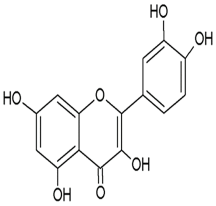 |
Coriandrum sativum, Brassica oleracea, Allium cepa |
Activates AMPK signal pathway in preadipocytes as a result decrease in vitro adipogenesis. | [72,73] |
| Catechins | 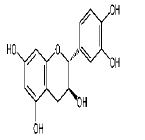 |
Camellia sinensis, Coffea and Vitis vinifera | Decreases the carbohydrate absorption because catechin inhibits α-glucosidase activity and small-intestine micelle formation. | [74-76] | |
| Resveratrol |  |
Arachis hypogaea, Vitis vinifera and Cyanococcus |
Inhibits adipogenesis by reducing the transcriptional activity of PPARγ and it enhances lipolysis. | [77,78] | |
| Galangin | 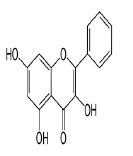 |
Alpinia galangal, Helichrysm aureonitens | Decreases accumulation of hepatic triglycerides, serum lipids, liver weight and lipid peroxidation. | [79] | |
| Phloretin-3′,5′-di-C-glucoside | 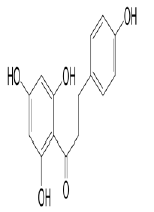 |
Cyclopia falcata, and Cyclopia subternata | Inhibit adipogenesis, intracellular triglyceride and down regulate peroxisome proliferator-activated receptor-2 (PPAR-2) expression and in in vitro condition. | [80] | |
| Alkaloids | Caffiene | 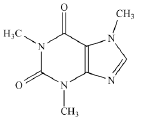 |
Camellia sinensis and, Coffea arabica | Exert lipolytic and thermogenic actions. | [81,82] |
| Capsaicin |  |
Capsicum annuum | Enhanced lipid oxidation and increased energy expenditure. | [83] | |
| Nicotine | 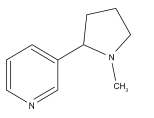 |
Nicotiana tabacum and Capsicum annum |
Nicotine increases metabolic rate and decrease food intake. | [84] | |
| p-synephrine |  |
Citrus aurantium and Citrus unshiu |
The active constituent p-synephrine increases metabolic rate, energy expenditure and increase in weight loss. | [85,86] | |
| Halfordinol |  |
Aegle marmelos | Anti-adipogenic activity and responsible for the decrease in adipocyte accumulation. | [87] | |
| Phenols | Chlorogenic acid | 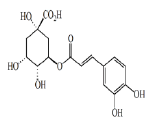 |
Glycine max and Coffea canephora | Reduce body fat due to a reduction in the absorption of glucose. | [88] |
| Ferulic acid | 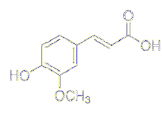 |
Hordeum vulgare and Asparagus officinalis |
Hypolipidemic effect, dysregulated lipid profiles and inhibition of adipocyte differentiation. | [89,90] | |
| Phytosterol | Sitosterol |  |
Arachis hypogaea, Citrullus Colocynth and Bauhinia variegata | Decreases cholesterol absorption by lowering the level of low density lipoprotein-cholesterol and inhibits pancreatic lipase. | [91-93] |
| Diosgenin |  |
Trigonella foenum-graecum and Dioscorea villosa |
Inhibits accumulation of triglyceride and expression of lipogenic genes. | [94,95] | |
| Protodioscin |  |
Trapa natans and Tribulus terrestris | Significantly reduces blood levels of triglyceride, cholesterol, low density lipoprotein (LDL) and increases high-density lipoproteins (HDL). | [96] | |
| Terpenoid | Punicic acid | 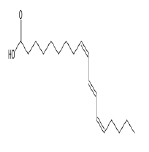 |
Punica granatum, Momordica balsamina and Trichosanthes bracteata |
Punicic acid binds and activates PPAR-α and γ, thus upregulating PPAR α and its responsive genes (Stearoyl-CoA desaturase-1, SCD1;Carnitinepalmitoyltransferase 1, Cpt-1; and acyl-coenzyme A dehydrogenase) as well as PPAR γ-responsive genes expression (CD36 and Fatty Acid Binding Protein 4, FABP4) in intra-abdominal white adipose tissue while suppressing expression of the inflammatory cytokine TNF-α and NF-κB activation. | [97,98] |
| Betulinic acid | 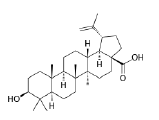 |
Orthosiphon aristatus and Syzygium aromaticum | Active constituent suppresses hypothalamic protein tyrosine phosphatase 1B and enhances the antiobesity effect of leptin. | [99,100] |
Table 1: Classes of phytochemical and their antiobesity effect(s)
Flavonoids
Flavonoids are group of plant metabolites containing 15 Carbon (C) atoms. Flavonoids are gaining interest because of their potential role in the prevention of diseases such as cancer and gastrointestinal, cardiovascular and neurodegenerative diseases [51]. Quercetin shows anti-lipase activity prevents adipogenesis and induces cell death in mouse pre-adipocytes [52,53]. Kaempferol extracted from Bauhinia forficate leaves reduced hyperglycemia [54]. Isorhamnetin found in medicinal plants such as Ginkgo biloba, Hippophae rhamnoides, Oenanthe javanica and Opuntia ficus-indica has anti-obesity activities [55].
Alkaloids
Alkaloids are a class of naturally occurring secondary metabolites with more than 2000 known compounds, mostly containing basic nitrogen atoms. Alkaloids include synephrine from Citrus aurantium, piperine from Piper nigrum, piperlongumine from Piper longum and liensinine, isoliensinine, neferine and nuciferine from Nelumbo nucifera have potential effect on obesity [56]. Caffeine and chlorogenic acid are the principal constituents of green coffee bean extract. Green coffee causes reduction in body mass and body fat due to a decrease in the absorption of glucose. Decrease in glucose absorption would eventually cause an increase in the utilization of fat reserves, due to the reduced availability of glucose as an energy source [57,58].
Phenols
Phenols are an abundant class of naturally occurring phytochemicals such as p -coumaric, caffeic acid, ferulic acid, cinnamic acid, ellagic and p -hydroxybenzoic acid which have shown to modulate physiological and molecular pathways that are involved in energy metabolism, adiposity and obesity [59]. Simple phenolic acids are non-flavonoid phenolic compounds conjugated with other natural chemicals such as flavonoids, alcohols, hydroxyfatty acids, sterols, and glucosides. Ferulic acid has hypolipidemic, hypocholesterolemic, hypoglycemic effect and thus it could be effective in lowering the risk of high fat diet-induced obesity [60,61]. Chlorogenic and coumaric acid cause significant inhibition of cell growth as well as enhance apoptosis. Gallic acid although does not affect the adipocyte cell cycle yet it did increase the number of apoptotic cells [62].
Phytosterols
Phytosterols predominantly occurring in nature are structurally similar to mammalian cell-derived cholesterol [63]. Phytosterols exist in both esterified and free alcohol forms. The prominent sources of phytosterols are unrefined vegetable oils, seeds, cereals, nuts and legumes [64]. Phytosterols appear to reduce obesity are diosgenin, campesterol, brassicasterol, sitosterol, stigmasterol and guggulsterone. High intakes of these compounds decrease LDL-cholesterol levels. In the intestinal lumen, phytosterols compete with cholesterol for micelle formation and thus effectively inhibit the cholesterol absorption [65]. Their influence on intestinal genes and transcription factors make phytosterols the key regulators in metabolism and cholesterol transport in the expression of liver genes [66].
Terpenoids
Terpenoids (isoprenoids) are chemically-modified terpenes usually found in plants, and comprise more than 40,000 compounds of both primary and secondary metabolism. Gymnemic acid (from Gymnema sylvestre ), oleanolic acid (from Panax ginseng) and corosolic acid (from Lagerstroemia speciosa L) have potential therapeutic on obesity [67-69]. PPARγ activation attenuates obesity and type-2 diabetes. Geranyl geraniol, farnesol and geraniol terpenoids are ligands with potential to activate PPAR, dietary lipid sensors that control energy homeostasis as well as lipid and carbohydrate disorders [70,71].
Conclusion
Complete understanding of plant-derived metabolites involved in fat metabolism in our body will open the avenues to develop the phytomolecules-based therapeutic approaches to combat obesity in human. Hardly any of the existing drugs including statins (Orlistat) has been established to firmly cure obesity. Phytomolecules are potential alternative treatment strategies for the development of effective and safe anti-obesity drugs. Phytomolecules being of biological origin have little side effects in comparison to statins. Emerging studies have described the promising role of phytomolecules in treating obesity with little side effects in human. Hence concerted efforts are required to explore plants as important natural resources for their therapeutic potential, not only to manage and treat obesity but other diseases, too.
Acknowledgements
The financial support from Department of Environment, Science and Technology (DEST), Government of Himachal Pradesh, Shimla to one of the authors (SSK) as well as to the Bioinformatics Centre, Department of Biotechnology, Himachal Pradesh University, Shimla (India) are thankfully acknowledged. Further the authors have no conflict of interest either among themselves or with the parent institution at their place of work.
References
- Swinburn BA, Sacks G, Hall KD, McPherson K, Finegood DT, et al. (2011) The global obesity pandemic: Shaped by global drivers and local environments. Lancet 378: 804-814.Â
- Verma RK, Paraidathathu T (2014) Herbal medicines used in the traditional Indian medicinal system as a therapeutic treatment option for overweight and obesity management: A review. Int J Pharm Pharm Sci 6: 40-47.
- Raina GS (2011) Obesity being the major health burden needed to be chased: A systemic review. J Appl Pharm Sci 1: 238-245.
- Obata A, Okauchi S, Kimura T, Hirukawa HH, Tanabe A, et al. (2017) Advanced breast cancer in a relatively young man with severe obesity and type 2 diabetes mellitus. J Diabet Invest 8: 395-396.
- Arroyo-Johnson C, Mincey KD (2016) Obesity epidemiology worldwide. Gastroenter Clini North Amer 45: 571-579.
- Liu Y, Sun M, Yao H, LiuY, Gao R, et al. (2017) Herbal medicine for the treatment of obesity: An overview of scientific evidence from 2007 to 2017. Evid Based Complement Alternat Med 2017: 1-17.
- Kravchun P, Kadykova O, Gabisoniia T (2012) The role of adipokines in formation of lipid and carbohydrate metabolic disorders in patients with cardiovascular disease. Georgian Med News 213: 26-31.
- Singh S, Kanwar SS (2017) Antilipase activity guided fractionation of Vinca major. J King Saud Univ Sci.
- Padwal RS, Majumdar SR (2007) Drug treatments for obesity: Orlistat, sibutramine, and rimonabant. Lancet 369: 71-77
- Kang JG, Park CY (2012) Anti-obesity drugs: A review about their effects and safety. J Diabetes Metab 36: 13-25.
- Gonzalez-Castejon M, Rodriguez-Casado A (2011) Dietary phytochemicals and their potential effects on obesity: A review. Pharmacol Res 64: 438-455.Â
- Mohamed GA, Ibrahim RM, Elkhayat ES, Dine RSE (2014) Natural anti-obesity agents. Bull Fac Pharm Cairo Univ 52: 269-284.
- Singh S, Jarial R, Kanwar SS (2013) Therapeutic effect of herbal medicines on obesity: Herbal pancreatic lipase inhibitors. Wudpecker J Med Plants 2: 53-65.
- Anderson AS, Key TJ, Norat T, Scoccianti C, Cecchini M, et al. (2015) European code against cancer 4th edition: Obesity, body fatness and cancer. Cancer Epidemiol 39: 34-45.Â
- Romieu I, Dossus L, Barquera S, Blottiere HM, Franks PW, et al. (2017) Energy balance and obesity: What are the main drivers? Cancer Causes Control 28: 247-258.
- Kadowaki T, Hara K, Yamauchi T, Terauchi Y, Kazuyuki T, et al. (2003) Molecular mechanism of insulin resistance and obesity. Exper Biol Med 228: 1111-1117.
- Hofbauer KG (2002) Molecular pathways to obesity. Int J Obes 26: 18-27.
- Klop B, Elte JWF, Cabezas MC (2013) Dyslipidemia in obesity: Mechanisms and potential targets. Nutrients 4: 1218-1240.
- Galuska DA, Khan LK (2001) Obesity: A public health perspective. In: Present Knowledge in Nutrition (8th edn), International Life Sciences Institute, Washington.
- Ng M, Fleming T, Robinson M, Thomson B, Graetz N, et al. (2014) Global, regional, and national prevalence of overweight and obesity in children and adults during 1980-2013: a systematic analysis for the Global Burden of Disease Study. Lancet 384: 766-781.
- Lunagariya NA, Patel NK, Jagtap SC, Bhutani KK (2014) Inhibitors of pancreatic lipase: State of the art and clinical perspective. EXCLI J 13: 897-921.
- Hofbauer KG, Nicholson JR, Boss O (2007) The obesity epidemic: Current and future pharmacological treatments. Annu Rev Pharmacol Toxicol 47: 565-592.
- Cheung BMY, Cheung TT, Samaranayake NR (2013) Safety of antiobesity drugs. Ther Adv Drug Saf 4: 171-181.
- Arterburn DE, Crane PK, Veenstra DL (2004) The efficacy and safety of sibutramine for weight loss: A systematic review. Arch Intern Med 164: 994-1003.
- Mechanick JI, Youdim A, Jones DB, Garvey WT, Hurley DL, et al. (2013) Clinical practice guidelines for the perioperative nutritional, metabolic, and nonsurgical support of the bariatric surgery patient—2013 update: Cosponsored by American Association of Clinical Endocrinologists, The Obesity Society, and American Society for Metabolic & Bariatric Surgery. Obesity 21: 1-27.
- Ikramuddin S, Korner J, Lee WJ, Bantle JP, Thomas AJ, et al. (2016) Durability of addition of roux-en-Y gastric bypass to lifestyle intervention and medical management in achieving primary treatment goals for uncontrolled type 2 diabetes in mild to moderate obesity: A randomized control trial. Diabetes Care 39: 1510-1518.
- Park JY, Kim YJ (2016) Laparoscopic Roux-en-Y gastric bypass in obese Korean patients: Efficacy and potential adverse events. Surg Today 46: 348-355.
- Briskin DP (2000) Medicinal plants and phytomedicines. Linking plant biochemistry and physiology to human health. Plant Physiol 124: 507-514.
- Nielsen AZ, Mellor SB, Vavitsas K, Wlodarczyk AJ, Gnanasekaran T, et al. (2016) Extending the biosynthetic repertoires of cyanobacteria and chloroplasts. Plant J 87: 87-102.
- Mayer MA, Hocht C, Puyo A, Taira CA (2009). Recent advances in obesity pharmacotherapy. Curr Clin Pharmacol 4: 53-61.
- Han LK, Kimura Y, Okuda H (2005) Anti-obesity effects of natural products. Stud Nat Prod Chem 30: 79-110.
- Gregoire FM (2001) Adipocyte differentiation: From fibroblast to endocrine cell. Exp Biol Med 226: 997-1002.
- Moseti D, Regassa A, Kim WK (2016) Molecular regulation of adipogenesis and potential anti-adipogenic bioactive molecules. Int J Mol Sci 17: 2-24.
- Rizzo G, Disante M, Mencarelli A, Renga B, Gioiello A, et al. (2006) FXR promotes adipocyte differentiation and regulates adipose cell function in vivo. Mol Pharmacol 70: 1164-1173.
- Huang C, Zhang Y, Gong Z, Sheng X, Li Z, et al. (2006) Berberine inhibits 3T3-L1 adipocyte differentiation through the PPAR gamma pathway. Biochem Biophys Res Commun 348: 571-578.
- Kim HK, Nelson-Dooley C, Della-Fera MA, Yang JY, Zhang W, et al. (2006) Genistein decreases food intake, body weight and fat pad weight and causes adipose tissue apoptosis in ovariectomized female mice. J Nutr 136: 409-414.
- Yang JY, Della-Fera MA, Hartzell DL, Nelson-Dooley C, Hausman DB, et al. (2006) Esculetin induces apoptosis and inhibits adipogenesis in 3T3-L1 cells. Obes Res 14: 1691-1699.
- Greenberg AS, Shen WJ, Muliro K, Patel S, Souza SC, et al. (2001) Stimulation of lipolysis and hormone-sensitive lipase via the extracellular signal-regulated kinase pathway. J Biol Chem 276: 45456-45461.
- Szkudelska K, Szkudelski T, Nogowski L (2002) Daidzein, coumestrol and zearalenone affect lipogenesis and lipolysis in rat adipocytes. Phytomedicine 9: 338-345.
- Karmase A, Birari R, Bhutani KK (2013) Evaluation of anti-obesity effect of Aegle marmelos leaves. Phytomedicine 20: 805-812.
- Veeramachaneni GK, Raj KK, Chalasani LM, Annamraju SK, Js B, et al. (2015) Shape based virtual screening and molecular docking towards designing novel pancreatic lipase inhibitors. Bioinformatics 11: 535-542.
- Ono Y, Hattori E, Fukaya Y, Imai S, Ohizumi Y, et al. (2006) Antiobesity effect of Nelumbo nucifera leaves extract in mice and rats. J Ethnopharmacol 106: 238-244.
- Yamamoto M, Shimura S, Itoh Y, Ohsaka T, Egawa M, et al. (2000) Anti-obesity effects of lipase inhibitor CT-II, an extract from edible herbs, Nomame Herba, on rats fed a high-fat diet. Int J Obes Relat Metab Disord 24: 758-764.
- Yoshikawa M, Shimoda H, Nishida N, Takada M, Matsuda H, et al. (2002) Salacia reticulata and its polyphenolic constituents with lipase inhibitory and lipolytic activities have mild antiobesity effects in rats. J Nutr 132: 1819-1824.
- Zhao HL, Kim YS (2004) Determination of the kinetic properties of platycodin D for the inhibition of pancreatic lipase using a 1, 2-diglyceride-based colorimetric assay. Arch Pharm Res 27: 968-972.
- Sheng L, Qian Z, Zheng S, Xi L (2006) Mechanism of hypolipidemic effect of crocin in rats: Crocin inhibits pancreatic lipase. Eur J Pharmacol 543: 116-122.
- Klontz KC, Timbo BB, Street D (2006) Consumption of dietary supplements containing citrus aurantium (bitter orange)-California behavioral risk factor surveillance survey (BRFSS). Ann Pharmacother 40: 1747-1751.
- Baintner K, Kiss P, Pfuller U, Bardocz S, Pusztai A, et al. (2003) Effect of orally and intraperitoneally administered plant lectins on food consumption of rats. Acta Physiol Hung 90: 97-107.
- Avula B, Wang YH, Pawar RS, Shukla YJ, Schaneberg B, et al. (2006) Determination of the appetite suppressant P57 in Hoodia gordonii plant extracts and dietary supplements by liquid chromatography/ electrospray ionization mass spectrometry (LC-MSD-TOF) and LCUV methods. J AOAC Int 89: 606-611.
- MacLean DB, Luo LG (2004) Increased ATP content/production in the hypothalamus may be a signal for energy-sensing of satiety: Studies of the anorectic mechanism of a plant steroidal glycoside. Brain Res 1020: 1-11.
- Fernandes I, Pérez-Gregorio R, Soares S, Mateus N, de Freitas V (2017) Wine Flavonoids in Health and Disease Prevention. Molecules 22: 1-30.
- Zheng CD, Duan YQ, Gao JM, Ruan ZG (2010) Screening for anti-lipase properties of 37 traditional Chinese medicinal herbs. J Chin Med Assoc 73: 319-324.
- Fang XK, Gao J, Zhu DN (2008) Kaempferol 875 and quercetin isolated from Euonymus alatus improve glucose uptake of 3T3-L1 cells without adipogenesis activity. Life Sci 82: 615-22.
- Jorge AP, Horst H, de Sousa E, Pizzolatti MG, Silva FR (2004) Insulinomimetic effects of kaempferitrin on glycaemia and on 14c-glucose uptake in rat soleus muscle. Chem Biol Interact 149: 89-96.
- Rodriguez-Rodriguez C, Torres N, Gutierrez-Uribe JA, Noriega LG, Torre-Villalvazo I, et al. (2015) The effect of isorhamnetin glycosides extracted from Opuntia ficus-indica in a mouse model of diet induced obesity. Food Funct 6: 805-815.
- Acharya D, Shrivastava A (2008) Indigenous herbal medicines: Tribal formulations and traditional herbal practices. Aavishkar Publishers Distributors, Jaipur.
- Thom E (2007) The effect of chlorogenic acid enriched coffee on glucose absorption in healthy volunteers and its effect on body mass when used long-term in overweight and obese people. J Inter Med Res 35: 900-908.
- Tajik N, Tajik M, Mack I, Enck P (2017) The potential efects of chlorogenic acid, the main phenolic components in coffee, on health: A comprehensive review of the literature. Eur J Nutr 56: 2215-2244.
- Nobili S, Lippi D, Witort E, Donnini M, Bausi L, et al. (2009) Natural compounds for cancer treatment and prevention. Pharmacol Res 59: 365-78.
- Son MJ, Rico CW, Nam SH, Kang MY (2010) Ferulic Acid on the lipid metabolism and antioxidative status in high fat-fed mice. J Clin Biochem Nutr 46: 150-156.
- de Melo TS, Lima PR, Carvalho KMMB, Fontenele TM, Solon FRN, et al. (2017) Ferulic acid lowers body weight and visceral fat accumulation via modulation of enzymatic, hormonal and inflammatory changes in a mouse model of high-fat diet-induced obesity. Braz J Med Biol Res 50: 1-8.
- Hsu CL, Yen GC (2006) Introduction of cell apoptosis in 3T3-L1 pre941 adipocytes by flavonoids is associated with antioxidant activity. Mol Nutri Food Res 50: 1072-1079.
- Gupta AK, Savopoulos CG, Ahuja J, Hatzitolios AI (2011) Role of phytosterols in lipidlowering: Current perspectives. QJM 104: 301-308.
- Berger A, Jones PJH, Abumweis SS (2004) Plant sterols: Factors affecting their efficacy and safety as functional food ingredients. Lipids Heal Dis 4: 3-5.
- Izar MC, Tegani DM, Kasmas SH, Fonseca FA (2011) Phytosterols and phytosterolemia: Gene-diet interactions. Genes Nutr 6: 17-26.
- Â Jesch ED, Lee JY, Carr TP (2008) Dietary plant sterols regulate genes involved in cholesterol metabolism in mouse liver but not intestine. FASEB J 22: 700-735.
- Kanetkar P, Singhal R, Kamat M (2007) Recent advances in indian herbal drug research, Gymnema sylvestre: A memoir. J Clin Biochem Nutr 41: 77-81.
- Klein G, Kim J, Himmeldirk K, Cao Y, Chen X, et al. (2007) Anti-diabetes and anti-obesity activity of lagerstroemia speciosa. Evid Bas Compl Alternat Med 4: 401-407.
- Osman M, Fayed SA, Ghada IM, Romeilah RM (2010) Protective effects of chitosan, ascorbic acid and Gymnema sylvestre against hypercholesterolemia in male rats. Aust J Bas App Sci 4: 89-98.
- Takahashi N, Kawada T, Goto T, Yamamoto T, Taimatsu A, et al. (2002) Dual action of isoprenols from herbal medicines on both PPARγ and PPARα in 3T3-L1 adipocytes and HepG2 hepatocytes. FEBS Lett 514: 315-322.
- Goto T, Takahashi N, Hirai S, Kawada T (2010) Various terpenoids derived from herbal and dietary plants function as PPAR modulators and regulate carbohydrate and lipid metabolism. PPAR Res 2010: 1-9.
- Ahn J, Lee H, Kima S, Parka J, Taeyoul H, et al. (2008) The anti-obesity effect of quercetin is mediated by the AMPK and MAPK signaling pathways. Biochem Biophys Res Commun 373: 545-549.
- Choi EY, Lee H, Woo JS, Jang HH, Hwang SJ, et al. (2015) Effect of onion peel extract on endothelial function and endothelial progenitor cells in overweight and obese individuals. Nutrition 31: 1131-1135.
- Pan H, Gao Y, Tu Y (2016) Mechanisms of body weight reduction by black tea polyphenols. Molecules 2: 1-11.
- Muramatsu K, Fukuyo M, Hara Y (1986) Effect of green tea catechins on plasma cholesterol level in cholesterol-fed rats. J Nutr Sci Vitaminol 32: 613-622.
- Fischer-Posovszky P, Kukulus V, Tews D, Unterkircher T, Debatin KM, et al. (2010) Resveratrol regulates human adipocyte number and function in a Sirt1-dependent manner. Amer J Clin Nutr 92: 5-15.
- Zhao Y, Chen B, Shen J, Wan L, Zhu Y, et al. (2017) The beneficial effects of quercetin, curcumin, and resveratrol in obesity oxidative medicine and cellular longevity. Oxid Med Cell Longev 2017: 1-8.
- Zhang XH, Huang B, Choi SK, Seo JS (2012) Anti-obesity effect of resveratrol-amplified grape skin extracts on 3T3-L1 adipocytes differentiation. Nutr Res Pract 6: 286-293.
- Kumar S, Alagawadi KR (2013) Anti-obesity effects of galangin, a pancreatic lipase inhibitor in cafeteria diet fed female rats. Pharm Biol 51: 607-613.
- Dudhia Z, Louw J, Muller C, Joubert E, de Beer D, et al. (2013) Cyclopia maculata and Cyclopia subternata (honeybush tea) inhibits adipogenesis in 3T3-L1 pre-adipocytes. Phytomed 20: 401-408.
- Hursel R, Westerterp-Plantenga MS (2013) Catechin- and caffeine-rich teas for control of body weight in humans. Am J Clin Nutr 98: 1682-1693.
- Shimoda H, Seki E, Aitani M (2006) Inhibitory effect of green coffee bean extract on fat accumulation and body weight gain in mice. BMC Complement Altern Med 6: 1-9.
- Zheng J, Zheng S, Feng Q, Zhang Q, Xaio X, et al. (2017) Dietary capsaicin and its anti-obesity potency: from mechanism to clinical implications. Biosci Rep 37: 1-9.
- Tucci SA (2010) Phytochemicals in the control of human appetite and body weight. Pharma 3: 748-763.
- Moro CO, Basile G (2000) Obesity and medicinal plants. Fitoterap 71: 73-82.
- Dragull K, Breksa AP, Cain B (2008) Synephrine content of juice from Satsuma mandarins (Citrus unshiu Marcovitch). J Agric Food Chem 56: 8874-8878.
- Patra S, Nithya S, Srinithya B, Meenakshi SM (2015) Review of medicinal plants for anti-obesity activity. Transl Biomed 6: 1-22.
- Corso MP, Vignoli JA, Benassi MT (2016) Development of an instant coffee enriched with chlorogenic acids. J Food Sci Technol 53: 1380-1388.
- Mir SA, Shah MA, Ganai SA, Ahmad T, Gani M, et al. (2017) Understanding the role of active components from plant sources in obesity management. J Saud Soci Agric Sci.
- Seo CR, Yi B, Oh S, Kwon SM, Kim S, et al. (2015) Aqueous extracts of hulled barley containing coumaric acid and ferulic acid inhibit adipogenesis in vitro and obesity in vivo. J Funct Foods 12: 208-218.
- Gamboa-Gomez CI, Rocha-Guzman NE, Gallegos-Infante JA, Moreno-Jimenez MR, Vázquez-Cabral BD, et al. (2015) Plants with potential use on obesity and its complications. Excli J 14: 809-831.
- Talabani NS, Tofiq DI (2012) Citrullus colocynthis as a bioavailable source of β-sitosterol, antihyperlipidemic effect of oil in rabbits. Int J Med Arom Plant 2: 536-539.
- Patil MM, Anand T, Ilaiyaraja N, Khanum F (2017) In-vitro antioxidant and anti-obesity properties of Bauhinia Variegata. Def Life Sci J 2: 128-132.
- Kumar P, Bhandari U (2015) Common medicinal plants with antiobesity potential: A special emphasis on fenugreek. Anc Sci Life 35: 58-63.
- Naskar KK, Mishra O (2017) Action of diosgenin and homoeopathic pathogenesis of Dioscorea villosa. Indian J Res Homeopathy 11: 5-11.
- Wang T, Choi RC, Li J, Cathy WC, Zang L, et al. (2010) Antihyperlipidemic effect of protodioscin, an active ingredient isolated from the rhizomes of Dioscorea nipponica. Planta Med 76: 1642-1646.
- Adnyana IK, Sukandar EY, Yuniarto A (2014) Anti-obesity effect of the pomegranate leaves ethanol extract. Punica granatum in high-fat diet induced mice. Inter J Pharm Pharm Sci 6: 626-631.
- Aruna P, Venkataramanamma D, Singh AK, Singh RP (2016) Health benefits of punicic acid: A Review. Compr Rev Food Sci Food Saf 15: 16-27.
- Choi YJ, Park SY, Kim JY, Won KC, Kim BR, et al. (2013) Combined treatment of betulinic acid, a PTP1B inhibitor, with Orthosiphon stamineus extract decreases body weight in high-fat-fed mice. J Med Food 16: 2-8.
- Silva FSG, Oliveira PJ, Duarte MF (2016) Oleanolic, ursolic, and betulinic acids as food supplements or pharmaceutical agents for type 2 diabetes: promise or illusion? J Agric Food Chem 64: 2991-3008.
Citation: Sharma T, Kanwar SS (2018) Phytomolecules for Obesity and Body Weight Management. J Biochem Cell Biol 1: 101.
Copyright: ©2018 Sharma T, et al. This is an open-access article distributed under the terms of the Creative Commons Attribution License, which permits unrestricted use, distribution, and reproduction in any medium, provided the original author and source are credited.
Select your language of interest to view the total content in your interested language
Share This Article
Recommended Journals
Open Access Journals
Article Usage
- Total views: 8068
- [From(publication date): 0-2018 - Jul 14, 2025]
- Breakdown by view type
- HTML page views: 6895
- PDF downloads: 1173

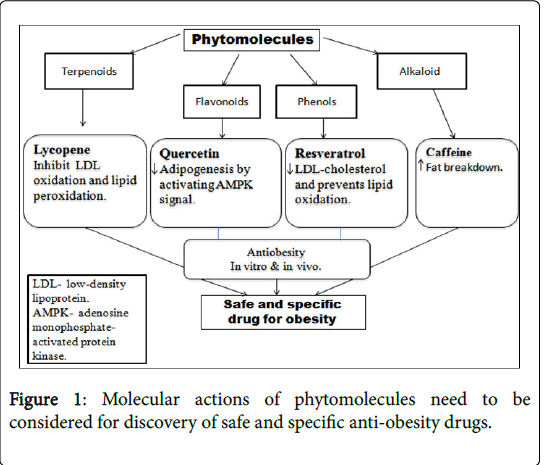
 Indicates inhibition; → Indicates faclitation).
Indicates inhibition; → Indicates faclitation).